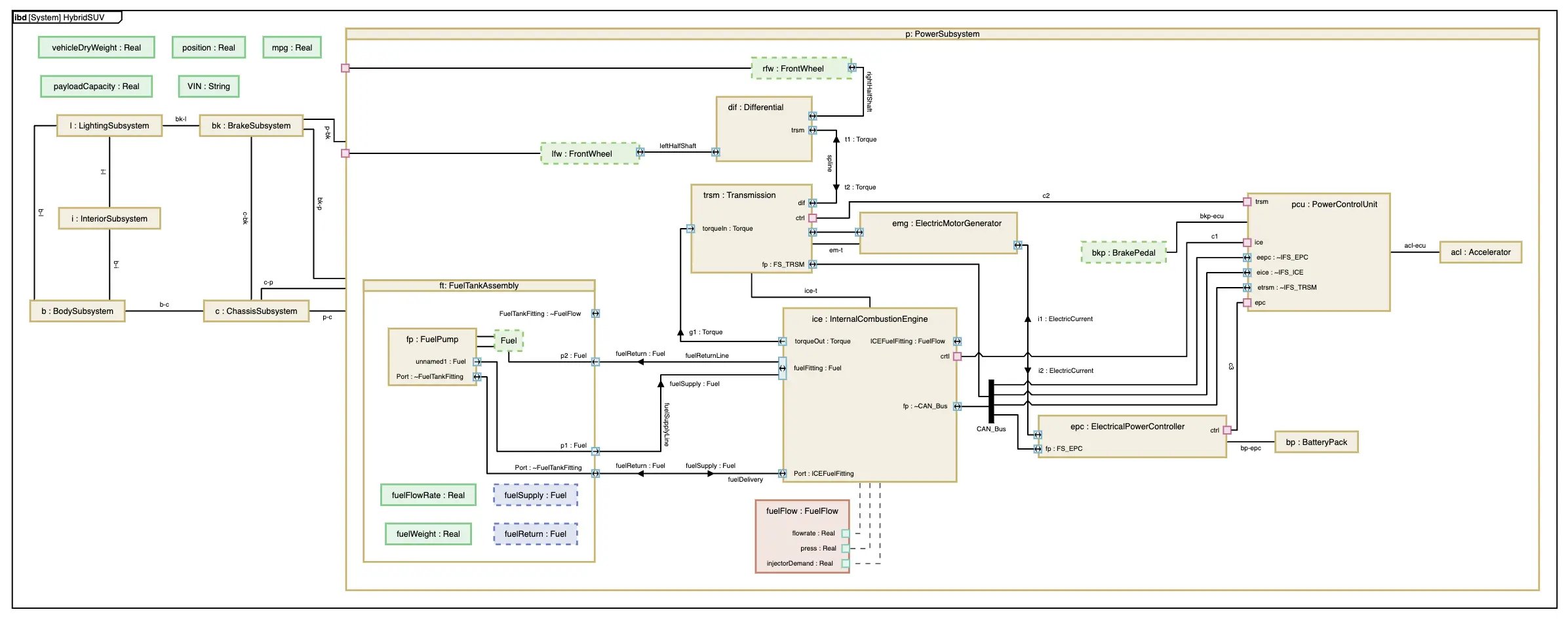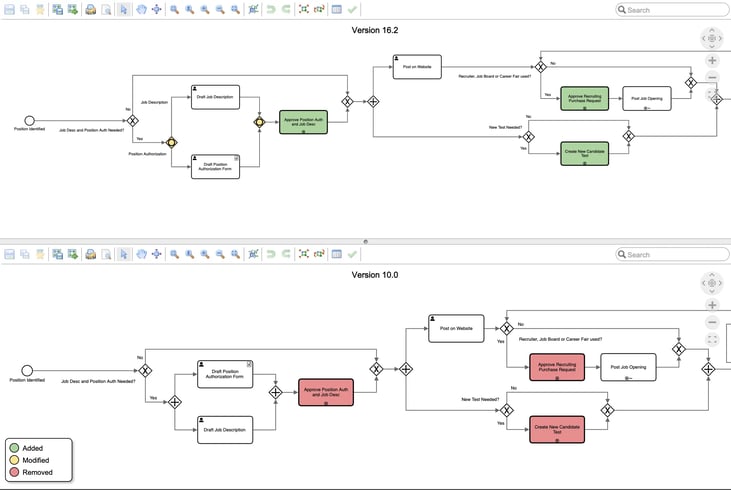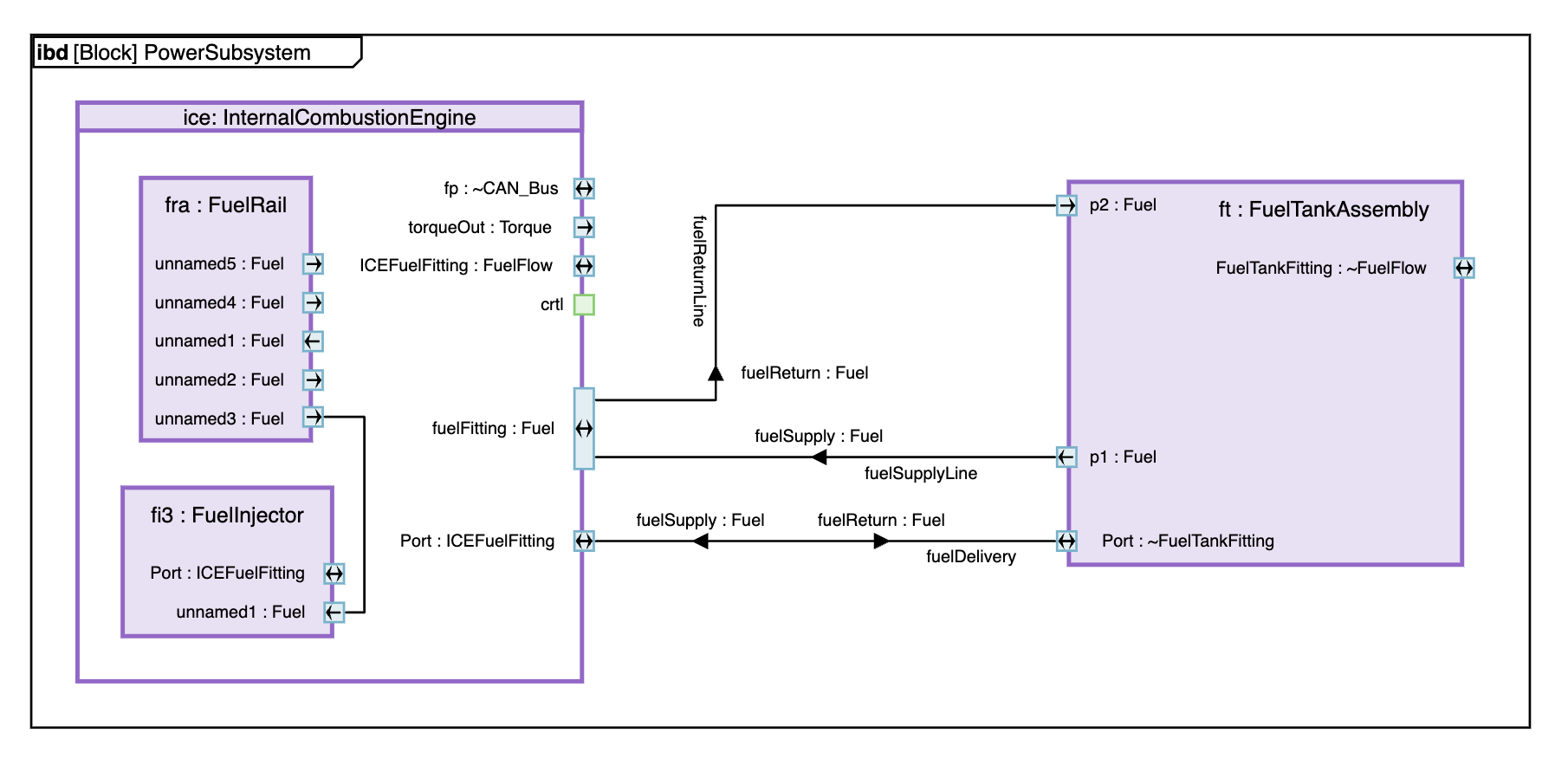Agile Systems Engineering (ASE) represents a transformative approach in the realm of complex engineering projects. By integrating the agility and responsiveness of agile methodologies with the systematic and disciplined approach of traditional systems engineering, ASE offers a dynamic and efficient path to managing and executing complex engineering projects in our rapidly evolving technological landscape.

Automatic MBSE visualization created with Tom Sawyer Perspectives.
Understanding Agile Systems Engineering
Agile Systems Engineering (ASE) marks a significant shift in the way complex systems are developed and managed. It blends the adaptability and iterative nature of Agile methodologies with the systematic and comprehensive approach of traditional systems engineering. This fusion leads to a more dynamic development process capable of responding swiftly to changes and incorporating stakeholder feedback effectively. Understanding ASE involves grasping these dual aspects and recognizing their potential to transform the engineering landscape.
Delving deeper into ASE, it becomes clear that this approach is not merely about applying Agile principles to systems engineering in a superficial manner. Instead, it requires a fundamental rethinking of engineering processes and methodologies. At its core, ASE advocates for a more collaborative and transparent workflow, where cross-functional teams work closely to iterate and refine system components in real-time. This collaboration extends beyond just the engineering teams to include stakeholders, end-users, and other relevant parties, ensuring that the final product is not only technically sound but also closely aligned with user needs and expectations.
In practice, ASE often involves the use of methodologies like Scrum, Kanban, or Lean, adapted to fit the unique requirements of systems engineering. For instance, Scrum can be used to organize work into sprints, allowing for regular reassessment and realignment of the project goals and deliverables. Meanwhile, Lean principles help in identifying and eliminating waste in processes, thereby optimizing efficiency and resource utilization.
The Core Principles of Agile in Systems Engineering
The essence of Agile Systems Engineering lies in its core principles which emphasize adaptability, customer collaboration, and responsiveness to change. Diverging from the traditional linear and rigid methodologies, ASE adopts an iterative and incremental approach. This method fosters a more flexible and responsive environment, enabling engineers to efficiently address and incorporate changes and new requirements throughout the project lifecycle.
Agile Systems Engineering Frameworks and Models
Agile Systems Engineering is supported by various frameworks and models, such as the Agile Systems Engineering Life Cycle Model (ASELCM). These frameworks provide a structured yet flexible methodology for system development, ensuring that all aspects, including design, testing, and requirements, are continuously revisited and refined to adapt to changing needs and insights.
Model Based Systems: Integrating Traditional and Agile Approaches
Agile Systems Engineering (ASE) marks a significant shift in the way complex systems are developed and managed. This shift is particularly evident in the integration of Model-Based Systems (MBS) with Agile approaches, a combination that addresses the need for a more responsive and iterative development process while maintaining the rigor and structure of traditional models. MBS provides a solid foundation for engineering, allowing for detailed analysis and design, while its combination with Agile methodologies ensures flexibility and continuous improvement in the development lifecycle.

Visualizing complex agile processes enables iterative evaluation, reassessment, and realignment of project goals.
The integration of these two methodologies is a response to the growing complexity of systems and the need for a more adaptive approach to engineering. Traditional model-based approaches, while thorough and systematic, often lack the flexibility to adapt to rapid changes in technology or user requirements. Agile methodologies, on the other hand, offer this flexibility but can sometimes fall short in addressing the intricate details and complexities inherent in large-scale system development.
In a model-based system that integrates Agile approaches, the planning, execution, and evaluation stages of a project are iterated in a cyclical fashion, akin to Agile's iterative cycles. This method allows for constant reassessment and realignment of the project goals with the actual progress and emerging challenges. It also facilitates early and frequent testing of the system, ensuring that potential issues are identified and addressed promptly, thus reducing the risks and costs associated with late-stage changes in traditional models.
The integration of Model Based Systems with Agile approaches also opens up opportunities for leveraging advanced tools and technologies. For instance, simulation and modeling software can be used in conjunction with Agile management tools to provide a comprehensive view of both the progress of the project and the performance of the system being developed. This combination of tools and methodologies ensures that systems are not only built correctly according to specifications but are also built to adapt and evolve in response to future needs and challenges.
Bridging the Gap Between Model-Based and Agile Methodologies
Model-Based Systems Engineering (MBSE) serves as a bridge between traditional systems engineering and agile methodologies. MBSE facilitates a detailed and structured approach to system design and analysis, while its integration with Agile practices introduces the benefits of iterative development and stakeholder collaboration. This convergence enables more effective management of complex engineering projects, enhancing both the efficiency and adaptability of the development process.
Case Studies: Agile MBSE in Action
Various case studies demonstrate the successful application of Agile MBSE across different industries, such as aerospace, defense, and automotive. These instances highlight the method's ability to improve system quality, enhance customer satisfaction, and reduce time-to-market. For instance, in aerospace, Agile MBSE has been crucial in managing complex aircraft design projects, allowing for rapid iterations and adjustments in design while maintaining a coherent system perspective.
Agile MBSE: A Synergistic Blend of Agility and Model-Based Techniques
Agile Model-Based Systems Engineering (MBSE) stands at the intersection of agility and detailed system modeling. This approach synergizes the rapid and flexible nature of Agile with the precision and thoroughness of model-based techniques. Agile MBSE enhances the capability to manage complex projects by allowing for quicker adaptations to changes without compromising the integrity and coherence of the system design.
The synergy of Agile MBSE lies in its ability to blend two seemingly disparate worlds: the fast-paced, iterative environment of Agile methodologies, and the structured, meticulous domain of model-based systems engineering. This blend enables teams to quickly respond to changes in requirements, market conditions, or technology, while still maintaining a clear and comprehensive understanding of the system as a whole.
In Agile MBSE, models are not static artifacts; they are dynamic and evolve continuously as the project progresses. This dynamic nature of modeling allows for better risk management and more informed decision-making, as the models provide a current view of the system and its potential future states. This continuous evolution of models is crucial in complex projects, where early decisions can have far-reaching implications on the system's final outcome.
Implementing Agile MBSE also involves leveraging various Agile practices such as backlogs, sprints, and retrospectives, adapted to suit the needs of systems engineering. These practices help in managing workloads, prioritizing tasks, and continuously improving processes based on feedback and lessons learned. Moreover, Agile MBSE emphasizes the importance of stakeholder involvement throughout the project, ensuring that the system developed aligns with the end-users' needs and expectations.
Overall, Agile MBSE represents a significant advancement in the field of systems engineering. It brings together the best of both worlds, offering a methodology that is both efficient and effective for the development of complex, high-quality systems. As technology continues to evolve and projects become increasingly complex, Agile MBSE provides a robust framework for navigating these challenges, ensuring that systems are not only built correctly but are also built to adapt and thrive in an ever-changing world.
The Role of MBSE in Agile Systems Engineering
MBSE plays a pivotal role in Agile Systems Engineering, providing a robust and structured framework that complements the agile principle of continuous delivery and customer-centric development. This synergy enhances the engineering process's overall effectiveness and efficiency, leading to faster, more reliable, and higher-quality system developments.
Implementing Agile MBSE in Complex Projects
Implementing Agile MBSE in complex projects requires the integration of agile practices such as Scrum, sprints, and product backlogs into the model-based engineering process. This combination fosters a more collaborative and adaptable environment, where changes can be quickly integrated, and the system can evolve in response to stakeholder feedback and changing requirements.
Evolution of Systems Engineering Models in the Agile Era
The Agile Era has ushered in a significant evolution of systems engineering models. Traditional models, once characterized by their linearity and rigidity, are now being reshaped to support the principles of Agile Systems Engineering. This evolution is characterized by a greater emphasis on flexibility, iterative development, and stakeholder collaboration, ensuring that systems engineering models remain relevant and effective in a rapidly changing technological environment.
This transformation is driven by the increasing complexity of systems and the need to adapt quickly to new technologies and market demands. The traditional approach to systems engineering often involved a waterfall methodology, where each phase of the project had to be completed before moving on to the next. While this method provided a clear structure, it lacked the agility needed in today’s fast-paced development cycles, where requirements can change frequently, and time-to-market is crucial.
In response to these challenges, systems engineering models have evolved to incorporate Agile methodologies. This evolution sees a shift towards iterative development, where systems are built incrementally, and each iteration is evaluated and improved upon. This approach allows for early detection and resolution of issues, continuous integration of feedback, and the ability to refine requirements and designs throughout the project lifecycle.
The use of Model-Based Systems Engineering (MBSE) has also been transformed in the Agile Era. MBSE, which involves creating comprehensive models of a system’s architecture and components, now incorporates Agile practices such as backlogs and sprints. This integration allows for a more dynamic modeling process, where models are continuously updated and refined to reflect the latest understanding of the system.
Finally, the Agile Era has emphasized the importance of customer and end-user involvement in the systems engineering process. By engaging these stakeholders throughout the project, engineers can ensure that the system meets real-world needs and can be adapted as those needs evolve. This user-centric approach is a key tenet of Agile methodologies and is now becoming integral to modern systems engineering practices.

A model of a power sub-system of an electric vehicle.
From Traditional to Agile: The Transformation of Systems Engineering Models
In the agile era, traditional systems engineering models undergo a significant transformation. These models, which once emphasized linear and sequential development, are now being adapted to support the iterative and flexible nature of Agile Systems Engineering. This adaptation involves rethinking how components are designed, tested, and integrated, allowing for ongoing modifications and improvements throughout the system's lifecycle.
Agile-Lean Mindset in Modern Systems Engineering
The Agile-Lean mindset is increasingly being adopted in modern systems engineering, characterized by a focus on reducing waste, optimizing processes, and enhancing value delivery. This mindset aligns with agile principles of delivering high-quality products efficiently and responsively. It entails a cultural shift in engineering teams, fostering collaboration, continuous learning, and a commitment to delivering value-driven engineering solutions.
Embracing Model-Based Engineering in Agile Frameworks
Embracing Model-Based Engineering (MBE) within Agile frameworks is about leveraging the strengths of both approaches to optimize the engineering process. MBE's focus on detailed modeling and analysis complements the Agile emphasis on iterative development and responsiveness. This amalgamation leads to a more comprehensive and efficient approach to system development, capable of handling the complexities and nuances of modern engineering projects.
The integration of MBE into Agile frameworks represents a strategic response to the challenges of contemporary system development. In an era where the pace of technological innovation is rapid and the complexity of systems is escalating, the need for a method that is both thorough and adaptable has never been greater. Model-Based Engineering offers a way to create detailed and precise representations of systems, which is crucial for understanding and managing complex interactions and dependencies. When combined with the flexibility and iterative nature of Agile methodologies, it creates a powerful tool for managing change and uncertainty.
One of the key benefits of integrating MBE with Agile is the ability to maintain a high level of system understanding and control, while also being able to react quickly to changes in requirements, technology, or market conditions. This is achieved through the continuous refinement of system models, which serve as a central point of reference throughout the development process. These models provide a clear and up-to-date picture of the system, allowing teams to make informed decisions and adjustments in an agile manner.
Another aspect of embracing MBE in Agile frameworks is the use of advanced tools and technologies to support the engineering process. This includes software for modeling and simulation, which allows for virtual testing and validation of system designs, as well as Agile project management tools to track progress and manage tasks. The use of these tools enhances the efficiency and effectiveness of the development process, allowing for faster iteration and more accurate results.
The Convergence of Model-Based Engineering and Agile Practices
The convergence of Model-Based Engineering (MBE) with Agile practices represents a significant advancement in systems engineering. MBE's structured approach to designing and documenting systems complements the iterative and adaptive nature of Agile. This convergence enables more efficient workflows, better management of complexities, and fosters innovation in system development.
Agile Systems Engineering Life Cycle Model (ASELCM) Explained
The Agile Systems Engineering Life Cycle Model (ASELCM) is a key framework that illustrates the integration of agile practices into the systems engineering lifecycle. It outlines a structured yet adaptable approach to system development, emphasizing continuous refinement and iteration of all system aspects. ASELCM ensures that systems are developed in a way that is responsive to changing requirements and stakeholder feedback, leading to more effective and sustainable engineering outcomes.
Agile Systems Engineering in Practice
In practice, Agile Systems Engineering translates into a more fluid, collaborative, and responsive approach to developing complex systems. It involves applying Agile principles such as iterative development, continuous feedback, and cross-functional teamwork in the context of systems engineering. This practical application results in faster delivery, higher quality outputs, and systems that are better aligned with user needs and evolving technological trends.
The real-world implementation of Agile Systems Engineering is characterized by its emphasis on practicality and adaptability. Teams working under this paradigm are encouraged to adopt a flexible mindset, one that embraces change as a natural and beneficial part of the development process. This flexibility is crucial in dealing with the uncertainties and rapid changes typical in complex projects, allowing teams to pivot and adjust their strategies as new information and requirements emerge.
A key aspect of Agile Systems Engineering in practice is the focus on delivering functional increments of the system at regular intervals. This approach, often referred to as incremental development, allows stakeholders to see and evaluate the system's progress continually. It provides opportunities for early testing and validation, ensuring that any discrepancies or issues can be addressed promptly, thereby reducing the risk and cost associated with late-stage changes.
Moreover, Agile Systems Engineering fosters a culture of collaboration and open communication. Regular meetings, such as daily stand-ups or sprint reviews, are integral to this approach, providing platforms for team members to synchronize their work, discuss challenges, and share insights. This ongoing communication ensures that everyone is aligned with the project goals and that any impediments to progress are quickly identified and addressed.
Incorporating user feedback is another critical component of Agile Systems Engineering in practice. By engaging end-users and stakeholders throughout the development cycle, teams can ensure that the system is being developed in alignment with actual user needs and preferences. This user-centric approach not only enhances the system's usability and relevance but also fosters a sense of ownership and satisfaction among users.
Another crucial aspect of the practical implementation of Agile Systems Engineering is how specific Systems Engineering tools enable the adaptability and increased communication. For example, Tom Sawyer Software's Model-Based Engineering allows realtime and dynamic visualization of the model with diagrams targeted to specific stakeholders. Tools like these make the model the single source of truth such that little to no time is invested in communicating changes between the team members. External publishing of these model also aids in keeping the end-user engaged while keeping control of the level of detail visible by them. Finally, the visualization of requirement traceability to the concrete model components facilitates scoping down the impact of changes to the requirements within the quickly evolving environment of Agile methodologies.

An IBD diagram automatically generated with Tom Sawyer Model-Based Engineering.
Incremental and Iterative Development in Agile Systems Engineering
In practice, Agile Systems Engineering is characterized by its incremental and iterative development approach. This method allows for frequent reassessments and adaptations of the project, ensuring that the final system aligns closely with user needs and market changes. It facilitates early and continuous delivery of functional components, reducing the risks associated with large-scale system development and enabling quicker responses to feedback and new insights.
Achieving Systems Engineering Agility in Diverse Industries
The agility provided by Agile Systems Engineering is beneficial across various industries, from aerospace and defense to healthcare and automotive. In each sector, ASE enables organizations to manage complex engineering projects more efficiently, adapt to technological advancements rapidly, and meet the ever-changing demands of customers and markets. The agility achieved through this approach is crucial for maintaining a competitive edge in today's fast-paced and technology-driven world.
Future of Agile Systems Engineering: Trends and Predictions
The future of Agile Systems Engineering is poised to be shaped by emerging trends and technological advancements. Predictions point towards greater integration of AI and machine learning, increased automation in engineering processes, and a continuous push towards higher efficiency and adaptability. Staying ahead in this dynamic field will require engineers to continually update their skills and strategies, embracing new tools and methodologies that align with the evolving nature of Agile Systems Engineering.
As we look forward to the horizon of Agile Systems Engineering, several key trends and predictions stand out. First and foremost is the growing influence of artificial intelligence (AI) and machine learning (ML) in the engineering process. These technologies are expected to revolutionize the way systems are designed, developed, and maintained. AI and ML can provide predictive analytics, automate routine tasks, and enhance decision-making processes, leading to more efficient and effective engineering outcomes. The integration of these advanced technologies within Agile frameworks will enable faster iteration cycles, more accurate simulations, and the ability to handle increasingly complex systems.
Another significant trend is the move towards greater customization and user-centric design. As Agile methodologies continue to emphasize the importance of stakeholder feedback, future Agile Systems Engineering projects will likely focus more on creating bespoke solutions tailored to specific user needs and preferences. This shift will require a deeper understanding of user experiences and a more nuanced approach to system design, ensuring that the end products are not only functional but also intuitive and user-friendly.
Sustainability and eco-efficiency are also expected to become more prominent in Agile Systems Engineering. With growing awareness of environmental issues and the need for sustainable practices, future projects will likely incorporate eco-friendly materials, energy-efficient processes, and lifecycle assessments to minimize environmental impact. Agile methodologies, with their focus on adaptability and continuous improvement, are well-suited to integrate these considerations into the engineering process.
Collaboration tools and platforms will continue to evolve, enhancing remote teamwork and cross-functional integration. As Agile Systems Engineering often involves multidisciplinary teams spread across different locations, advanced collaboration tools will be crucial in maintaining effective communication and coordination. These tools will support virtual workspaces, real-time data sharing, and seamless integration of various software used in the engineering process.
Innovations in Agile Systems Engineering
The future of Agile Systems Engineering is poised for continuous innovation. Emerging technologies like AI and machine learning are expected to play a significant role in further automating and optimizing the ASE process. These advancements will likely lead to even more efficient, accurate, and sophisticated engineering solutions, pushing the boundaries of what is possible in system development.
Preparing for the Future: Skills and Strategies for Agile Systems Engineers
As the field of Agile Systems Engineering evolves, so too must the skills and strategies of systems engineers. Future professionals in this field will need to be adept not only in traditional engineering principles but also in agile methodologies and the latest technological advancements. Continuous learning and adaptability will be key, as engineers will need to stay abreast of emerging trends and technologies to effectively apply ASE principles in a rapidly evolving landscape.
About the Author
Santiago Leon, Senior Product Development Engineer at Tom Sawyer Software, is passionate about software tool development and design. He is active in the Object Management Group (OMG) and has taken part in the development of the SysML 2.0 Specification, focusing on the graphical visualization of models.
FAQ
How does Agile Systems Engineering differ from traditional systems engineering?
Traditional systems engineering follows a linear, waterfall approach, where each phase must be completed before moving to the next. In contrast, Agile Systems Engineering is iterative and flexible, allowing for continuous testing, feedback, and adaptation throughout the project lifecycle.
Can Agile Systems Engineering be applied to small-scale projects?
Yes, Agile Systems Engineering can be scaled for both small and large projects. While it's particularly useful in complex projects, its principles of iteration, collaboration, and adaptability benefit smaller teams looking to improve efficiency and product quality.
How does Model-Based Systems Engineering (MBSE) support Agile methodologies?
Model-Based Systems Engineering (MBSE) supports Agile methodologies by providing a structured, continuously evolving model that aligns with Agile’s iterative development process. It allows teams to maintain an up-to-date, detailed visual representation of the system, a dynamic "single source of truth." This enables better decision-making, as teams can assess the impact of changes quickly and adapt accordingly. MBSE enhances collaboration by offering a shared understanding of complex system components, facilitating smooth feedback integration throughout sprints. Additionally, it enables early testing and validation through simulations, reducing risks and improving system quality within Agile’s fast-paced, iterative framework.
What tools are commonly used for graph visualization in Agile Systems Engineering?
Tools like Neo4j, Tom Sawyer Perspectives, or yEd Graph Editor are commonly used for graph visualization in Agile Systems Engineering. These tools allow teams to visually model complex systems, track dependencies, and simulate changes, which supports the iterative and adaptive nature of Agile methodologies.
What are the key success factors when implementing Agile Systems Engineering?
Key success factors include strong stakeholder involvement, effective communication across teams, adopting the right tools and technologies, and fostering a culture of continuous improvement. Successful implementation also requires a clear understanding of both Agile and systems engineering principles and a commitment to flexibility and collaboration.

Submit a Comment